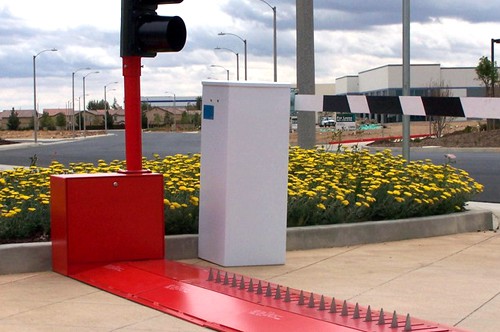How Traffic Teeth Work in the Real World

You may have seen scenes in movies or on television in which the bad guys are trying to get away, and it seems as though they might succeed in making their escape, but then they run over a set of traffic teeth while going the wrong direction. Their vehicle disabled, they cannot go any farther, so the good guys catch up with them and save the day.
Is this how it happens in reality? Sort of. Real-life use of traffic teeth is usually less dramatic. For example, they are intended to be used only at low speeds and may not be effective at stopping a vehicle traveling at a high velocity. Nevertheless, they are effective at controlling one-way traffic and crippling the vehicles of drivers attempting unauthorized access.
How Do Traffic Teeth Work?
Delta Scientific traffic teeth are set up to follow the direction that traffic is supposed to go. They are spring loaded so that, when a vehicle going the correct direction drives over them, they retract into their base without causing any damage. However, when a vehicle drives over them from the wrong direction, they deflate the tires by puncturing them. As a result, the vehicle can no longer move.
Where Can Traffic Teeth Be Applied?
One of the main purposes of traffic teeth is to deter vehicle theft. For example, a potential thief may sneak into an auto dealer’s lot or a car rental agency and attempt to make off with one of the vehicles by driving it away from the lot using a rarely used rear entrance. Traffic teeth would deter the theft by puncturing the tires. The vehicle would be immovable but undamaged; replacing the tires would restore it to a drivable state.
Another application for traffic teeth is to prevent drivers from trying to avoid parking fees. Some drivers will try to avoid paying for parking by trying to exit via the entrance to circumvent the attendant’s booth. Not only does this cheat the owner of the parking area, but it could cause an accident from the driver going the wrong way. Traffic teeth can deter fee evasion while allowing cars to enter from the correct direction unimpeded.
Public buildings and airports are examples of other places where traffic teeth could be of benefit for controlling the direction of traffic.
What Are the Benefits of Traffic Teeth?
Traffic teeth are especially good for low-to-medium security applications because they do not harm either the driver or the vehicle. The spikes of our traffic teeth are hollow, allowing the tires to deflate slowly when they get lodged in the rubber. This provides protection against injuries that may occur if a rapid deflation brought the car to a sudden stop.
Our traffic teeth are also designed to protect pedestrians who may accidentally trigger them by falling on or bumping into the unit. Within less than 1.5 seconds, the reliable electro-mechanical system rotates the Pedestrian-Friendly spikes into position.
Our traffic teeth are versatile. Because of the modular design, you can deploy our traffic teeth across an entryway up to 32 feet wide.
Sources:
http://www.ijarse.com/images/fullpdf/1523793820_PG706ijarse.pdf
https://www.rsisinternational.org/Issue0/issue8/645-650.pdf
Share This Story, Choose Your Platform!
